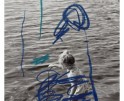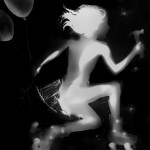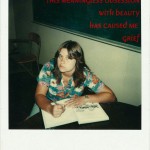On Collaboration: Hillerbrand+Magsamen

©Hillerbrand + Magsamen, Mythology, from the series ‘Higher Ground,’ 2012, Archival Inkjet Prints, 24”x30”.
One of the challenging aspects of a long-term collaboration is adapting to life’s ever-changing circumstances and still creating in the midst of all its distractions.
The team of Mary Magsamen and Stephan Hillerbrand are masters at brilliantly and continually weaving the complexities of daily life into their work as they probe the essence of the suburban nuclear family. From fog enveloping their dinner table to a chronicle of a family trip to the moon (complete with a gift shop), their staged documentary work exposes the tenuous underpinnings of existence. We admire their practical impracticality as they hold the line between immersion and satire – bending, breaking, mending, taping, reordering, and illuminating life.
Hillerbrand+Magsamen are interdisciplinary artists who create sculpture, installation, performance, video and photographic works to explore their relationships to each other and society with an uncanny sensibility that merges the real and unreal, blurring boundaries between life and art. Often including their children, Madeleine and Emmett in their work, the family critiques and playfully scrutinizes consumerism and family life with an experimental approach. Mary and Stephan live and work in Houston with their two children.

©Hillerbrand + Magsamen, Ophelia, from the series ‘Higher Ground,’ 2012, Archival Inkjet Prints, 24”x30”.
B+L: What do you gain from collaboration and what do you give up?
H+M: We gain so much from collaboration! We have been working together and married for over 15 years and our collaboration has been a source of growth for us personally and professionally. We see our life and our art practice as blurred together. Play is at the source of our work, so we have fun in the studio. There is always a project in progress in our house, which is also our studio so if we are having an argument we can’t stay mad at each other for too long! We also collaborate with other artists, writers and musicians – it is inspiring to work with other people and develop ideas together.
We met during our studies at Cranbrook Academy of Art, where we each earned our MFA degrees. It was clear early on that we would fuse our lives not only as a married couple but also as artistic partners. And so, our collaboration was born and we embarked on our journey of fusing our art and life. Our practice evolved very naturally to become a collaboration between two to now between four. As our kids, Maddie and Emmett, get older though, it is continuing to change.
What do we give up? Sometimes people don’t understand collaboration. It has caused some confusion when either of us has applied for teaching jobs. We have never gotten an interview as a team and have had people flat out tell us they won’t hire one of us individually because they don’t know how to handle the other. It can be difficult for people to understand that we really develop and create our work as a team while simultaneously being individuals.

©Hillerbrand + Magsamen, Sisyphus, from the series ‘Higher Ground,’ 2012, Archival Inkjet Prints, 24”x30”.
B+L: Do you have distinct roles in your collaboration, or in each project? How do you make this determination?
H+M: We do not have distinct roles in our collaboration. Sometimes Stephan will start with an idea, sometimes Mary – we will pitch it to each other and then begin to talk about how it could work. One morning Mary sat down with Stephan at breakfast and said, “I have an idea. I want to use a chain saw to cut up our couch. To make the family sofa into a love seat.” Stephan said, “Is there something wrong with our relationship? Why would you do that?!” So the idea for “DIY Love Seat” began with Mary but as we worked on it, it was completely collaborative.
We also always say that the digital environment of photography and video has made collaboration much easier for us because we are able to “Save As” – there is always a “Stephan” folder and a “Mary” folder and then a “Final” folder.

©Hillerbrand + Magsamen, Cerberus, from the series ‘Higher Ground,’ 2012, Archival Inkjet Prints, 24”x30”.
B+L: What is your work process? How do you develop ideas, exchange information? Are you working 24/7? How are your children a part of this?
H+M: We are always working. We always have a camera on a tripod somewhere in the house.
It is a 24/7 process for us where we are always developing ideas and projects –we will take any bit of time we can find to discuss a project! The best times are when we are in the car together—no distractions!
But more importantly, we are observing our lives, what is in our home and how we interact with each other. When we were working on the ‘Comfort’ project Mary came home to find Stephan walling himself up in the garage with all of the toys and junk that were stored in there. When she asked him about it, he said he started to clean the garage and then it turned into arranging objects and then to an art installation. Mary took that idea and photographed it and had the idea to print them out not as traditional photographs but on Polar Fleece blankets printed at Walmart.
As our children are getting older they are not as eager to participate. Now our teenage daughter wants to take the camera instead of being a subject for it, which is exciting to see her develop her own ideas and voice. We try to engage her as a collaborator. They get tired of seeing museums and galleries when we are on vacations or work trips, but that’s ok with us if that’s their biggest complaint.
We always joke that a family that makes art together stays together. Many artists work with themes of identity. Our identity is being a family. Our work deconstructs our iteration of the typical nuclear family into topical discussions of consumerism, class, and identity in contemporary American life. We ask, “What is a real family today?”

©Hillerbrand + Magsamen, Atlas, from the series ‘Higher Ground,’ 2012, Archival Inkjet Prints, 24”x30”
B+L: You cite that you are working in the Fluxus tradition, where the distinctions between art and life are blurred. Can you elaborate on how this approach has evolved for you?
H+M: The risk taking and bottom up approach of Fluxus has always been an inspiration for us, as well as the use of humor, tension and the uncanny. The use of everyday objects, events and happenings has been a connection for us as well. We capture our daily life, excess and interactions as a way to create a contemporary mythology or story of our lives.
We refer to our practice as a sort of “suburban fluxus,” that deconstructs and decontextualizes our family culture, community and our beliefs. By incorporating our whole selves and pulling from personal experiences, we take the everyday and transform it into spectacle. Life is too serious and stressful – it is good to laugh. We think about how everyday life is surreal – as they say, “life is stranger than fiction.”
In our collaborative practice, we embrace the risk that comes with pointing the camera at ourselves. We have always believed that the idea of using ourselves as subject matter would critically mirror back to viewers their own preconceptions and questions.

©Hillerbrand + Magsamen, Garage: Inside,’ from the series ‘Comfort,’ 2013, Polar Fleece Blankets printed at Walmart, 50”x60”.

©Hillerbrand + Magsamen, Documentation of series ‘Comfort,’ 2013, Two Polar Fleece Blankets printed at Walmart, 50”x60”.
B+L: Although on the surface your work is humorous and playful, there is an existential core that calls to mind the work of Anna and Bernhardt Blume…are they an influence on your work? From where do you draw inspiration?
H+M: While we admire Anna and Bernhardt Blume, they have not specifically influenced our work. The Fluxus artists have been our greatest influences including Joseph Beuys, Hannah Hoch, John Cage and Yoko Ono. Artists such as Gregory Crewdson, Sally Mann, Stan Van Der Beek, Ana Mendieta, Bill Viola and Pipilotti Rist are artists that we look at and filmmakers including Wes Anderson and the Cohen Brothers.
We also draw inspiration from everyday life and activities whether that is having family dinner, folding the laundry or having a cup of coffee – finding those moments that seem so banal and finding points that we can expand, explore and distort.

©Hillerbrand + Magsamen, Garage: Outside,’ from the series ‘Comfort,’ 2013, Polar Fleece Blankets printed at Walmart, 50”x60”.
B+L: What projects are in the works for you?
H+M: We are currently working on a project titled ‘Devices for Healing+Protection,’ which we are combining our photography, video and sculptural objects with a playwright and composer to create a performance. We will use all of these items to create a town hall like lecture where we are going to instruct people on how to use these imaginary devices that will help them cope with all of the things going on today. Devices like ‘A Device for Empathy’ or ‘A Device for Collaborative Breathing.’
We have always placed ourselves in front of the camera in a type of ‘performance’ but then we show the work as photographs or video. We have never performed live, in front of an audience. We are so scared but also excited!
Devices for Defense+Protection from Hillerbrand+Magsamen on Vimeo.

©Hillerbrand + Magsamen, ‘A Device for Patient Breathing ,’ from the series ‘Devices for Healing+Protection,’ 2017-18, Archival Inkjet Prints, 30”x30”.

©Hillerbrand + Magsamen, ‘A Device for Extra Time,’ from the series ‘Devices for Healing+Protection,’ 2017-18, Archival Inkjet Prints, 30”x30”.

©Hillerbrand + Magsamen, A Device for Removing Pain,’ from the series ‘Devices for Healing+Protection,’ 2017-18, Archival Inkjet Prints, 30”x30”.

©Hillerbrand + Magsamen, A Device for Outward Enjoyment,’ from the series ‘Devices for Healing+Protection,’ 2017-18, Archival Inkjet Prints, 30”x30”.

©Hillerbrand + Magsamen, A Device for Replenishment,’ from the series ‘Devices for Healing+Protection,’ 2017-18, Archival Inkjet Prints, 30”x30”.

©Hillerbrand + Magsamen, ‘A Device for Cooperative Tension,’ from the series ‘Devices for Healing+Protection,’ 2017-18, Archival Inkjet Prints, 30”x30”.
B+L: What do the neighbors think?
H+M: They think we are crazy, but they also love us and are eager to see what is coming up over the fence!
We lived in Brooklyn, NY for many years and we did not anticipate that we would like living in Houston, TX, but we have more space, more time and more energy to make work. Houston is a city of people doing all kinds of weird stuff in their backyards. It is a city of innovation and exploration, which is why we like it.
We always tell a wonderful story where one day Stephan was up on a ladder working on our rocket ship we built for the series “Higher Ground” and he looks over his shoulders to see our next-door neighbors who had just moved in and their mother looking over the fence at us. With mouths wide open you could tell they had never before seen a 3-story silver spaceship built from household objects before. Stephan gets down off the ladder and goes over to talk to them. After he explains the project to them, the mother starts to tell him all about her husband who had a patch making company that supplied all of the flight patches for NASA space flights. She thought it was wonderful.
Higher Ground, 2016, Video, Photography and Installation

©Hillerbrand + Magsamen, Rocket,’ from the series ‘Higher Ground,’ 2016, Archival Inkjet Prints, 40”x80”.

©Hillerbrand + Magsamen, Son,’ from the series ‘Higher Ground,’ 2016, Archival Inkjet Prints, 40”x80”.
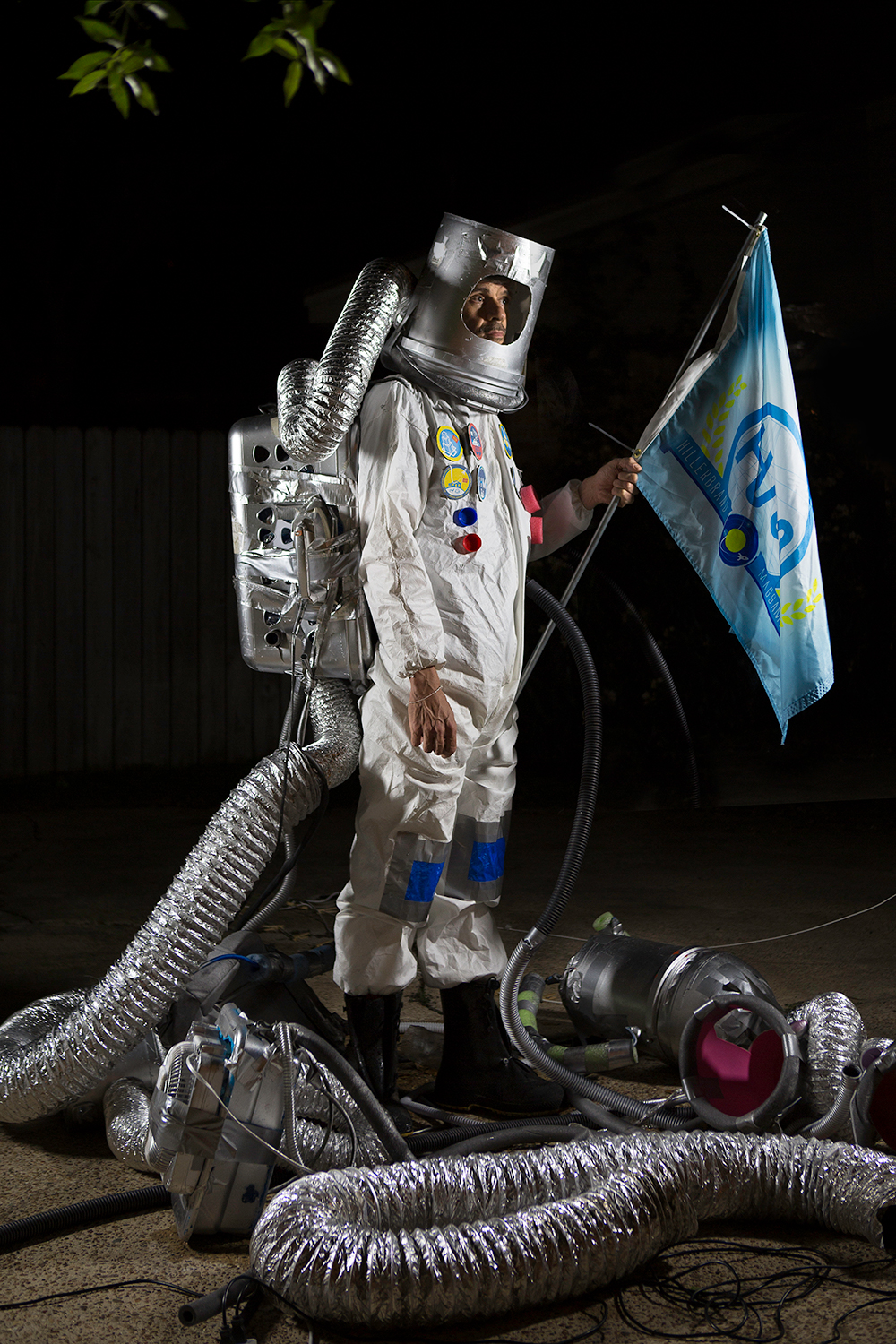
©Hillerbrand + Magsamen, ‘Dad,’ from the series ‘Higher Ground,’ 2016, Archival Inkjet Prints, 40”x80”.
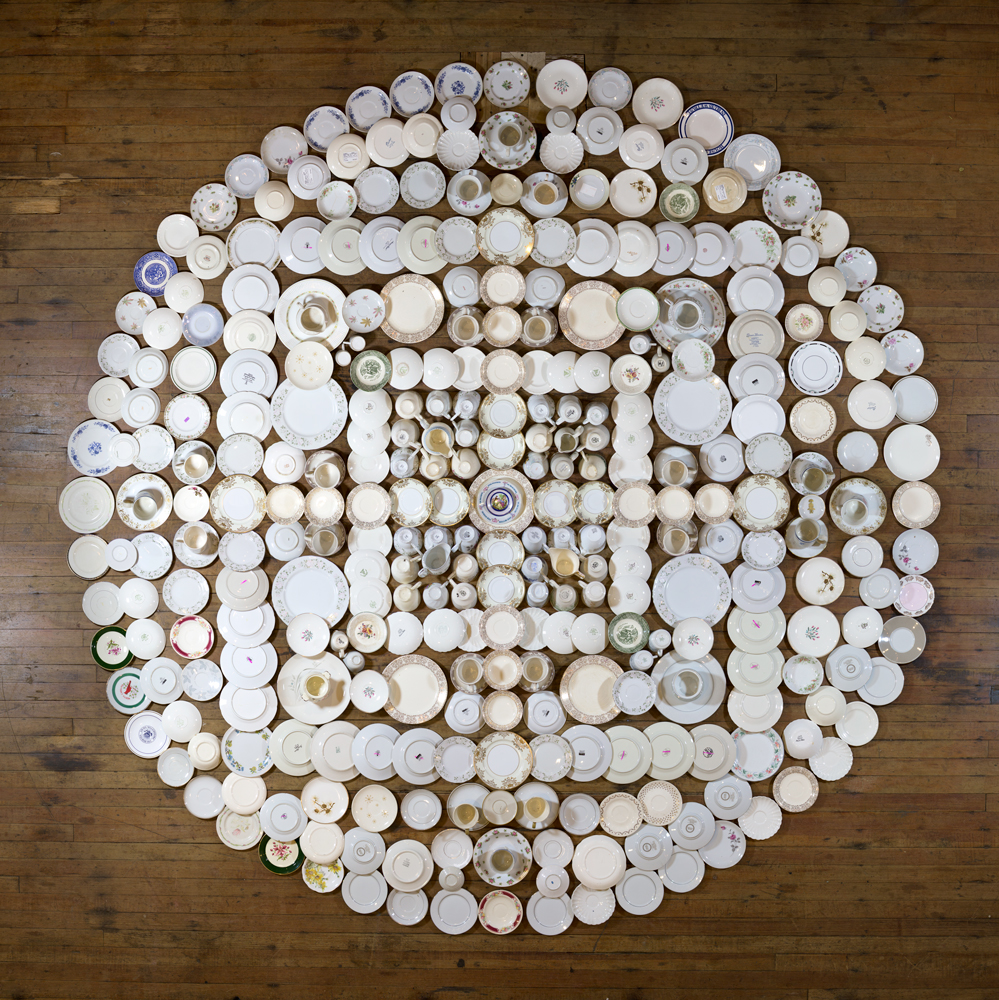
©Hillerbrand + Magsamen, ‘Plates,’ from the series ‘Mandala,’ 2016, Archival Inkjet Prints, 40”x40”.
Hillerbrand+Magsamen have presented their videos in international film and media festivals including Houston Cinema Arts Festival, London SciFi Film Festival, WAND V Stuttgarter Filmwinter, New York Underground Film Festival, Ann Arbor Film Festival, Boston Underground Film Festival and MonkeyTown. Their cinematic based installations have been exhibited at the Everson Museum (Syracuse, NY), Center for Photography Woodstock (Woodstock, NY), Diffusion Photography Festival (Wales, UK) and Houston Center for Photography (Houston, TX). They have received grants from Sustainable Arts Foundation, Austin Film Society, Experimental Television Center, Ohio Arts Council, Houston Arts Alliance and Houston Center for Photography. Their project HIGHER GROUND was a commission from the Houston Airport System.
Barbara Ciurej is a Chicago-based photographer and graphic designer. She has a BS in Visual Communications from the Institute of Design+Illinois Institute of Technology. Ever looking to the art historical past to invoke order and harmony, her search for narratives to explain the plight of how we got here has fueled 30+ years of making pictures.
Lindsay Lochman is a Milwaukee-based photographer and lecturer at the University of Wisconsin /Milwaukee. She received her MS in Visual Communications at the Institute of Design+Illinois Institute of Technology. In her quest to organize the natural world, she is inspired by the intersection of science, history and the unconscious.
Posts on Lenscratch may not be reproduced without the permission of the Lenscratch staff and the photographer.
Recommended
-
Earth Week: Ian van Coller: Naturalists of the Long NowApril 22nd, 2024
-
Amy Lovera in Conversation with Douglas BreaultJanuary 23rd, 2024
-
Brittany Marcoux in Conversation with Douglas BreaultJanuary 22nd, 2024
-
Penumbra / Image Threads LTP: Adam Meeks and Raymond Meeks in ConversationSeptember 9th, 2023
-
Penumbra Foundation / Image Threads LTP: Again and Again: Ruth Lauer-Manenti and Evan Davis in ConversationSeptember 7th, 2023





